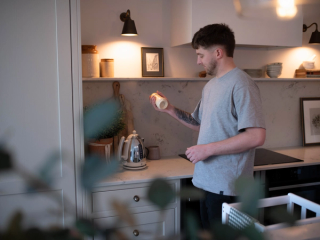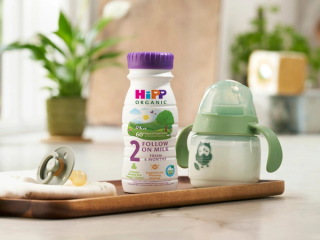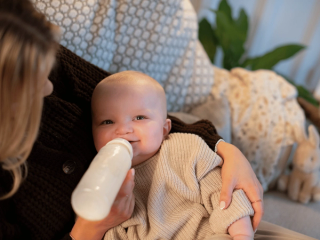
- Home
- Advice Hub
- Baby
- Baby Feeding
- Night Feeds
Night feeds
Night feeds are an essential part of caring for your baby and it is perfectly normal for babies to wake for several feeds during the night. In this article Laura, Sleep Expert, guides you through creating a plan for your night time feeds.
Night feeds are an essential part of caring for your baby, especially in the early days, and it is perfectly normal for babies to wake for several feeds during the night. There are no ‘rules’ about which age your baby will stop waking for feeds and start sleeping through the night, as every baby will do this at a slightly different time.
New born babies will wake every few hours to be fed during the night since they have such small tummies. It can be a tiring time, so one of the best things you can do is have everything you will need to hand for feeding during the night. If you are bottle feeding, have plenty of bottles sterilised and ready. If you are breastfeeding you may like to have a feeding pillow to hand and plenty of water for yourself. Don’t forget muslins, too!
From around 4 months you will likely start to see some patterns in your baby’s night feedings and you will start to fall into a more predictable rhythm. Within the first year babies sleep longer between needing to feed and often as they approach a year old they may be able to stop waking in the middle of the night.
There may come a time when you begin to wonder if your baby still needs all their feeds throughout the night and you may be considering night weaning. To establish if your baby is ready for this, I recommend keeping a log of feeds to discover if there is a pattern to their waking. You may also notice some feeds your baby feeds better than others. You can then use this to inform how you will respond to night waking in the future, perhaps offering feeds at some waking and pausing for others to see if your baby will settle without a feed.
When creating a plan for your night feeds there are two types of feeds you can use:
Dream feed
A dream feed is when you offer a feed to your baby without them waking for one. For example you may use this if you notice your baby usually needs a feed at around 11pm so you offer the feed at 10pm before going to bed yourself. A dream feed involves taking your baby out of the crib whilst asleep and offering either a breast or bottle feed. Your baby may remain asleep during this feed or rouse slightly, either is OK. After feeding and winding your baby, you can place them back in the cot. The idea is that offering a dream feed may help your baby sleep for a longer stretch.
Response feed
Your baby wakes and cries or calls for you and you offer them a feed. For this type of feed you will have decided which wakes you will be responding to with a feed. For example 'the first waking after midnight' or 'the first waking 4 hours from the last feed.'
When your baby wakes at these times you will go straight to them and feed with purpose, . It is important that you do not try to resettle them without a feed first and then feed them if that is not successful, as that will send mixed signals.
The other key thing with response feeds is not to feed baby back to sleep. I know this can be difficult and it's OK if your baby dozes off a little whilst feeding, but do try to rouse them a little so they are feeding effectively.
Both dream feeds and response feeds can be effective ways to provide nutrition for a baby during the night, but they require different approaches. Dream feeds require the parent to be able to feed the baby while they are still asleep, while response feeds require the parent to be responsive to the baby's needs and cues during the night. The best approach may depend on the baby's individual needs and the family's sleep and feeding preferences.
Whichever way you choose to approach night feeds, it is best to keep them calm and low key. You can do this by:
- Keeping lights dim and choosing a red-coloured night light, since this colour does not interfere with the sleep hormone melatonin
- Keep any white or pink noise playing throughout the feed. I recommend playing the sounds for the duration of the night, so keeping it playing will help baby settle back down more easily.
- Avoid nappy changes. Nappies are designed to last all night, so only change baby if they have soiled their nappy or it is very full.
- Keep interactions to a minimum. We want baby to learn that night- time is for sleeping and avoid any day and night confusion, so night feeds are not the time for chatting, tickling and playing with baby.
- Ideally avoid screens like TVs and phones as the blue light emitted is not helpful for baby (or you!) falling back to sleep. I know this is hard and you are trying to keep yourself awake. Try headphones with a podcast or audio book.
Feeding and sleep
It’s really common and normal for feeding to become your baby’s sleep association, meaning they need a feed in order to fall asleep. Sometimes this can become unsustainable for parents if they find other caregivers are unable to settle baby or baby is waking far too frequently. If this is the case and you would like to move away from feeding to sleep there are a few things you can do whilst still ensuring your baby gets the feeds they need during the night.
Firstly, look at your bedtime routine and when the final feed of the night happens, ideally we want to have a step between feeding and baby falling asleep. You can do this by bringing the feed slightly earlier in the routine and then either reading a story or singing a song before settling baby to sleep. If you find your baby is becoming too sleepy during the final feed, try offering a split feed with half happening before bath so you know they have a full tummy and a top up after bath before your final steps of the bedtime routine.
In doing this you may discover that your baby has difficulty falling asleep, because they no longer have the feed helping them. Here you can consider a sleep training approach that suits your parenting style, either gradually reducing how much you help your baby fall asleep or giving your baby some space and time to try and settle whilst checking in on them at regular intervals.
If your baby has a very strong feed-to-sleep association it may be helpful to layer additional sleep associations on before removing the feeding to sleep. This means that for a week or so you will continue to feed your baby to sleep whilst also patting, shushing, singing or stroking them. You will then be able to use these additional associations to help settle baby once you stop feeding to sleep.
Advice & tips

Want to read more? Join the HiPP BabyClub for full access to this article.
As a BabyClub member, you'll get access to a range of exclusive benefits, including:
Monthly competitions
Discounts from our Partners
Expert advice tailored to your little one's age
Weaning recipes
HiPP shop discounts*
*10% off HiPP's online shop does not apply to our First Infant, Anti-Reflux or Comfort Formula Milk.
Important notice: Breastfeeding is best. Follow on milk should only be used as part of a mixed diet from 6 months. Talk to a healthcare professional.
















